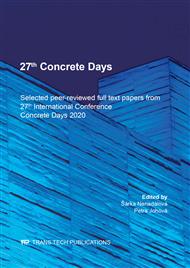[1]
M. Benýšek, R. Štefan, and J. Procházka. Analysis of fire resistance of concrete structural mem bers based on different fire models: An illustrative example of the slab panel assessment. In 25th Concrete Days 2018, volume 292 of Solid State Phenomena, pages 173-182. Trans Tech Publications, 7 (2019).
DOI: 10.4028/www.scientific.net/ssp.292.173
Google Scholar
[2]
M. Benýšek, R. Štefan, and J. Procházka. Effect of fire model parameter variability on determi nation of fire resistance of concrete structural members. In 26th Concrete Days 2019, volume 309 of Solid State Phenomena, pages 208-215. Trans Tech Publications, 9 (2020).
DOI: 10.4028/www.scientific.net/ssp.309.208
Google Scholar
[3]
M. Benýšek and R. Štefan. FMC - Fire Models Calculator. CTU in Prague, (2015).
Google Scholar
[4]
J. F. Cadorin and J. M. Franssen. A tool to design steel elements submitted to compartment fires-OZone V2. Part 1: pre and postflashover compartment fire model. Fire Safety Journal, 38(5):395-427, (2003).
DOI: 10.1016/s0379-7112(03)00014-6
Google Scholar
[5]
T. Deibjerg, B. P. Husted, H. Bygbjerg, and D. Westerman. Argos User's Guide. DIFT, (2003).
Google Scholar
[6]
EN 199112. Eurocode 1: Actions on structures - Part 12: General actions - Actions on struc tures exposed to fire. CEN, (2002).
DOI: 10.1002/9783433601570.oth1
Google Scholar
[7]
EN 199211. Eurocode 2: Design of concrete structures - Part 11: General rules and rules for buildings. CEN, (2004).
Google Scholar
[8]
EN 199212. Eurocode 2: Design of concrete structures - Part 12: General rules - Structural fire design. CEN, (2004).
Google Scholar
[9]
J. E. Floyd. Comparison of CFAST and FDS for Fire Simulation with the HDR T51 and T52 Tests. NISTIR 6866, (2002).
DOI: 10.6028/nist.ir.6866
Google Scholar
[10]
B. Karlsson and J. Quintiere. Enclosure Fire Dynamics. CRC Press, 2000.[11] J. H. Klote and G. P. Forney. Zone Fire Modeling with Natural Building Flows and a Zero Order Shaft Model. NIST, Gaithersburg, USA, (1993).
DOI: 10.6028/nist.ir.5251
Google Scholar
[12]
P. Kučera. Fire Engineering: Fire Dynamics (Požární inženýrství: dynamika požáru). SPBI, Ostrava, Czech Republic, 2009. (in Czech).
Google Scholar
[13]
P. Kučera and Z. Pezdová. Basics of Mathematical Modelling of Fire (Základy matematického modelování požáru). SPBI, Ostrava, Czech Republic, 2010. (in Czech).
Google Scholar
[14]
N. Lišková, K. Cábová, and F. Wald. OZone V3 User's Guide (OZone V3 Uživatelský manuál). CTU in Prague, 2018. (in Czech, translation).
Google Scholar
[15]
A. Lovatt. Comparison Studies of Zone and CFD Fire Simulations. Master thesis, School of Engineering, University of Canterbury, (1998).
Google Scholar
[16]
V. M. Nikitin. Wood and cellulose chemistry (Chémia dreva a celulózy). SVTL, Bratislava, 1956. (in Slovak).
Google Scholar
[17]
R. D. Peacock, K. B. McGrattan, G. P. Forney, and P. A. Reneke. CFAST - Consolidated Fire and Smoke Transport (Version 7), Volume 1: Technical Reference Guide. NIST Technical Note 1889v1, (2015).
DOI: 10.6028/nist.tn.1889v1
Google Scholar
[18]
R. D. Peacock, P. A. Reneke, and G. P. Forney. CFAST - Consolidated Model of Fire Growth and Smoke Transport (Version 7), Volume 2: User's Guide. NIST Technical Note 1889v2, (2017).
DOI: 10.6028/nist.tn.1889v1
Google Scholar
[19]
N. Svobodová. Analysis of zone fire models and their application in structural fire design (Analýza zónových modelů požáru a jejich aplikace při posuzování požární odolnosti konstrukcí). Master thesis, CTU in Prague, 2021. (in Czech).
Google Scholar
[20]
S. Tavelli, R. Rota, and M. Derudi. A critical comparison between CFD and zone models for the consequence analysis of fires in congested environments. Chemical Engineering Transactions, 36:247-252, (2014).
Google Scholar
[21]
R. Štefan. Transport Processes in Concrete at High Temperatures. Mathematical Modelling and Engineering Applications with Focus on Concrete Spalling. PhD thesis, CTU in Prague, (2015).
Google Scholar
[22]
R. Štefan and J. Procházka. TempAnalysis - Computer program for temperature analysis of crosssections exposed to fire. CTU in Prague., (2009).
Google Scholar
[23]
C. Wade. A User's Guide to BRANZFIRE 2004. Building Research Association of New Zealand, Judgeford, (2004).
Google Scholar
[24]
C. Wade, G. Baker, K. Frank, R. Harrison, and M. Spearpoint. BRISK 2016 user guide and technical manual. BRANZ Ltd and the University of Canterbury, (2016).
Google Scholar
[25]
F. Wald, M. Pokorný, K. Horová, P. Hejtmánek, H. Najmanová, M. Benýšek, M. Kurejková, and I. Schwarz. Fire Dynamics Modelling in Buildings (Modelování dynamiky požáru v budovách). CTU in Prague, Prague, Czech Republic, 2017. (in Czech).
Google Scholar
[26]
W. Wegrzynski, P. Tofilo, and R. Porowski. Hand calculations, zone models and CFD - areas of disagreement and limits of application in practical fire protection engineering. In SFPE 11th Conference on PerformanceBased Codes and Fire Safety Design Methods, (2016).
Google Scholar


